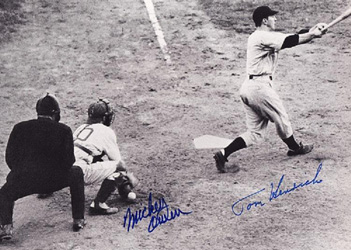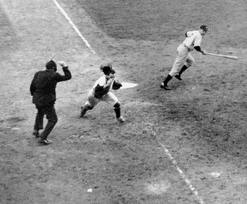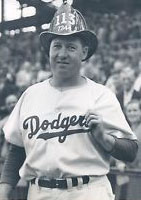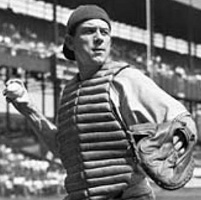|
Pivotal World Series Plays
Owen Muffs the Third Strike
1941 World Series Game 4: New York Yankees @ Brooklyn Dodgers
In his third year with the Dodgers, 27-year-old righthander Hugh Casey was manager Leo Durocher's "closer" although that term was not used at that time. Casey finished 25 games in relief, which was 16 more than the next Brooklyn pitcher. He had given up only three earned runs in his 11 September appearances as the Dodgers fended off the Cardinals to win the pennant by 2 1/2 games.
Casey drew the ire of Dodger fans in the third game of the World Series against the hated Yankees. With the Series tied at one game apiece, Manager Leo Durocher called on Casey to replace starter Freddie Fitzsimmons in the top of the 8th in a scoreless game. After a flyout, Hugh gave up four straight singles to Red Rolfe, Tommy Henrich, Joe DiMaggio, and Charlie Keller. With the Yankees in front 2-0, Durocher replaced Casey with Larry French.
The Dodgers got a run in the bottom of the eighth but no more against Marius Russo, who hurled a masterful four-hitter to give the Yankees a two games to one lead in the Series.
After the game, Dodgers President/General Manager Larry MacPhail castigated Casey for failing to warm up properly before relieving Fitzsimmons.
Casey got a chance to redeem himself the next day and make his critics eat their words.
Durocher summoned Casey with two outs in the top of the fifth. The Yankees, leading 3-2, had the bases loaded with two outs. Casey got Joe Gordon to fly out to end the threat. After Pete Reiser's two-run homer put the Dodgers on top 4-3 in the bottom of the 5th, Casey had a chance to be the winning pitcher if he shut down the Yankees the rest of the way.
Throwing his "quick" curve ball rather than his "sweeping" curve, the "big, burly righthander" shut down the Yanks through the eighth, allowing only two singles. However, the Dodgers could not add to their slim one-run lead.
Facing the top of the Yankee lineup, Casey got 1B Johnny Sturm to ground out to second base. Next up were the four batters who had singled off Hugh the day before.
When 3B Red Rolfe bounced to the mound, Casey was one out away from going from goat to hero in 24 hours.
That brought up RF Tommy Henrich, who was 0-for-3 in the game and just 2-for-14 for the Series.
Fortunately, Bob Elston's pitch-by-pitch call on Mutual Radio is available.
After ball one, a "half speed strike at the knees." 1-1
Same pitch and Henrich takes again. Now Casey is one strike from victory.
Henrich barely gets a piece of the ball and tops a roller foul.
Ball way outside. 2-2
Ball waist high, just misses the outside corner. 3-2
Henrich swings and misses at a big curve breaking down and in to the left-handed batter, which gets away from Owen and rolls to the backstop. Henrich reaches first on Owen's error.
  Owen misses third strike to Henrich. "Fortune is smiling on the Yankees," said Elston.
Still, Brooklyn's chances of evening the series looked good. There were two outs and a runner on first. But the third out proved elusive against the heart of the Yankee order.
CF Joe DiMaggio lines a single to left, sending Henrich to second.
LF Charlie "King Kong" Keller doubles off the screen above the right field wall, his fourth hit of the day, scoring Henrich and DiMaggio. Suddenly the Yankees lead 5-4.
C Bill Dickey walks.
2B Joe Gordon doubles over LF Jimmy Wasdell's head, scoring Keller and Dickey with the third and fourth unearned runs of the inning. Yankees 7 Dodgers 4
SS Phil Rizzuto walks.
P Johnny Murphy grounds out to SS Pee Wee Reese to end the nightmarish inning.
Leo Durocher's Dodgers went down 1-2-3 in the bottom of the ninth to fall behind in the Series three games-to-one.
The Yankees closed them out the next day.
In later years, Casey claimed he had thrown a spitball on the last pitch to Henrich in Game 4. But at a reunion in 1988, both Owen and Henrich disagreed. "If Casey threw a spitball, he threw it on his own," said Mickey. "It never looked like a spitball to me. It was a curveball. That's what I called for." "That's right," said Henrich. "Spitballs drop down. I swung at a big breaking curveball." "Casey had two kinds of curveballs," explained Owen. "One was an overhand curve that broke big. The other one was like a slider. It broke sharp and quick. But we had the same signs for either one. He just threw whichever one was working best. From the sixth inning when he came in, he had stopped the Yankees using the quick curve. He never tried the big overhand curve. When we got to 3 and 2 on Tommy, I called for the curveball. I was looking for the quick curve he had been throwing all along. But he threw the overhand curve, and it really broke big, in and down. Tommy missed it by six inches." Henrich added, "As soon as I missed it, I looked around to see where the ball was. It fooled me so much. I figured maybe it fooled Mickey, too. And it did." Owen explained his biggest regret about the passed ball. "The big mistake I made was not going out to the mound to tell Casey that I blew it. I just stood there behind the plate. I should've gone out to tell Casey that I blew it and to settle him down. But all of us were in shock from what happened." Tommy recalled, "When I got to first base, Dolph Camilli never said a word to me. Not a word." Owen: "I don't remember Leo Durocher saying much in the clubhouse. We were still in shock when Larry MacPhail came in. Larry was the general manager, and he always had something to say. I thought, 'I'm going to hear something now.' But he was feeling no pain. He came over and hugged and kissed me. I thought, 'I can't believe this.'" In the Yankee clubhouse, Henrich's locker was near DiMaggio's. "Even with all the noise," Henrich recalled, "I can still hear Joe saying, 'They'll never come back from this one.'" Months later, Owen asked Casey about the strike three pitch. Instead of saying it was a spitball, Hugh said, "It just happened." |


